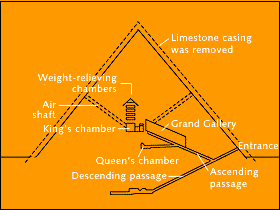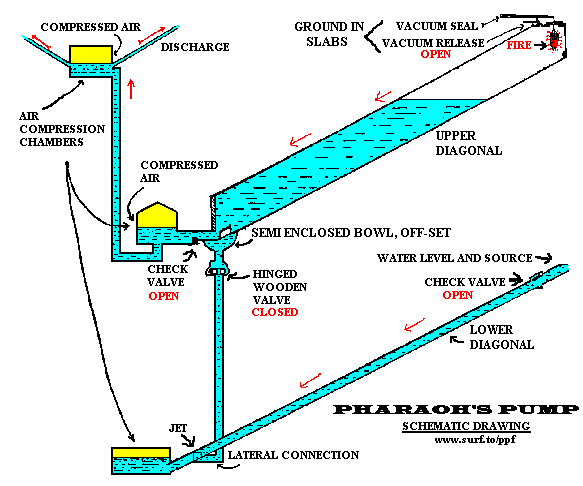

UPDATE:  Now there is a animated image of the Pharaoh's Pump. See how the
pump worked! Also there is an image map that you can use to see a
detailed explanation how each part functioned.
Now there is a animated image of the Pharaoh's Pump. See how the
pump worked! Also there is an image map that you can use to see a
detailed explanation how each part functioned.
 How the Great Pyramid
functioned as a Water
Pump!
The orange image is a simple diagram of the Great Pyramid provided
as a reference.
How the Great Pyramid
functioned as a Water
Pump!
The orange image is a simple diagram of the Great Pyramid provided
as a reference.

Below is a greatly simplified animated diagram and explanation of how
the Great Pyramid pumped water. The position of the upper diagonal
has been reversed to better clarify how the pump works. However, the shape
of the Pyramid will not permit such an arrangement of the various mechanical
elements. There are a great many refinements and complexities that will
not be address in this short and abbreviated explanation. The lower
diagram is a image map that will direct you to areas of interest.
From there you will find information of greater detail and depth of the
function of each pump component. There is also a very helpful FAQ
Page that answers specific and general questions about this material.
Take a moment and watch the action of the pump. It
is very unique and deserves a little time to get a feeling for how each
part relates to the rest of the pump. Below is an image that divides the
pump into its components.

Although the Great Pyramid is a pump, it doesn't look or operate like
any pump people are familiar with. This pump is powered by FIRE.
This fire is located at the top of the Grand Gallery. There is
still a very distinct aerodynamically shaped soot patter indicating the
location of this fire. The combustion of fire creates a partial vacuum
in the upper area of the airtight Grand Gallery. The result of this
partial vacuum is water is raised up the Grand Gallery. The fire
does not "go out" during each cycle. When the oxygen in the upper
part of the Grand Gallery is consumed, the fire smolders until the next
cycle is started.
At the same time the air in the subterranean chamber has been greatly
compressed by the water traveling down the descending passage. The
check valve in the top of the descending passage closes when the air in
the subterranean chamber is compressed to the maximum. Then the compressed
air pushes water through the "Jet," and the lateral connection.
This action pushes water up, thereby pushing up underneath on the water
in the Grand Gallery. This force pushing up on the water in the Grand Gallery
is somewhat similar to the workings of a hydraulic ram pump but on a gigantic
scale!
The above two forces move the water up the Grand Gallery!
After the water has risen in the Grand Gallery, the vacuum release valve,
(located at the top of the Grand Gallery by the fire) is opened, releasing
the partial vacuum created by the fire. This allows fresh air to
be introduced into the area above the water and causes the water to move
down the Grand Gallery. This repeated cycle of raising and lower
this ponderous column of water is analogous to the movement of a piston
back and forth in a cylinder!
The opening of the vacuum release valve at the top of the Grand
Gallery
starts the downward cycle.
When the vacuum valve is opened, the partial vacuum created by the fire
is replaced by fresh air and the water starts to move back down the Grand
Gallery. The normally closed check valve in the antechamber is opened
and the check valve just below the Grand Gallery is closed. This
moving ponderous column of water lowers and is directed into the "Queen's
Chamber." This movement of water compresses the air in the upper part of
the Queen's Chamber. The compressed air stores energy that is use
to push water up into the King's Chamber. This action compresses
air in the upper part of the King's Chamber and water is pushed out of
the pump through the vents. The antechamber valve shuts. The
highly compressed air in the upper part of the Queen's Chamber forces water
up into the King's Chamber. The discharge tubes in the King's Chamber are
located in the wall about 5 feet high. Above that, air is compressed
by the water coming from the Queen's Chamber. This compressed air
in this secondary chamber forces the water out the discharge tubes.
The use of highly compressed air is the force used to move water
above the column of water in the Grand Gallery.
The animation shows the water exiting the pump in a pulsating manner.
In reality, the stored energy in the form of compressed air allows the
water output from the pump to be constant. The Queen's compression chamber
supplies the King's compression chamber; which discharges water, to the
outside. In the Pyramid pump, the lower diagonal holds 88 tons of
water; while the upper diagonal has a capacity of 300 tons of water.
The pump itself when full, holds about 600 tons of water. Modern
hydraulic engineers, have a long way to go, to catch up with the Ancient
Engineers.
Select the area you want for more detailed information.

Don't just say that it won't work! The truth is that at one time
it did. Some of the information is technical but not incomprehensional.
Click on each area and see how it relates to the complete system. Check
out the FAQ Page and if you have a question or comment
let us know!
The Pharaoh's Pump Foundation is dedicated in both providing availability
for the information in the book Pharaoh's Pump and WE ARE GOING TO BUILD
A PUMP! The FAQ page has information on this project.

 The Great Pyramid Water Pump | How the
Great Pyramid was Built |
Home | FAQ | Links
Please send comments or questions regarding these web pages to
Pharaoh's Pump Foundation
Copyright © 1998 Pharaoh's Pump Foundation
(ppf stands for Pharaoh's Pump
Foundation)
I got it for free at http://come.to
The Great Pyramid Water Pump | How the
Great Pyramid was Built |
Home | FAQ | Links
Please send comments or questions regarding these web pages to
Pharaoh's Pump Foundation
Copyright © 1998 Pharaoh's Pump Foundation
(ppf stands for Pharaoh's Pump
Foundation)
I got it for free at http://come.to


![]() Now there is a animated image of the Pharaoh's Pump. See how the
pump worked! Also there is an image map that you can use to see a
detailed explanation how each part functioned.
Now there is a animated image of the Pharaoh's Pump. See how the
pump worked! Also there is an image map that you can use to see a
detailed explanation how each part functioned.


